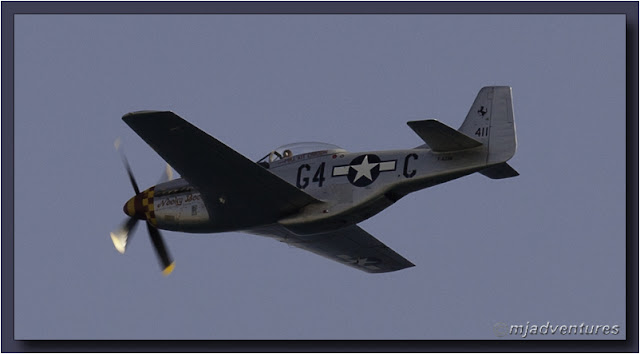Depending on which website I read, I found that this particular P-51 - Nooky Booky IV - was either listed as a P-51D or a P-51K. The difference between them was the factory location and the propeller diameter. The P-51K was manufactured in Dallas, Texas and fitted with a shorter 11" diameter propeller. It proved to be unreliable, and was later replaced with the original 11' 2" propeller.
Nooky Booky IV has a famous history. In WWII she flew with the 357th Fighter Group over Europe, and her pilot Major Leonard K. "Kit" Carson was the highest scoring Ace in the group with a tally of 18 and a half victories - achieved in only one tour of duty. Not sure what the "half" was - maybe a shared "kill"!
Although I can't find any mention of it, because of the prancing horse on the plane's tail, I'm also wondering if the original Packard V-1650 V12 piston engine has been replaced by a Ferrari engine.
The distinctive side profile of the P-51D Mustang
American-produced, the P-51 Mustang was actually built to British specifications. The original design was powered by the American Allison V-1710 engine, but when that proved to be unreliable at high altitudes, the British Rolls Royce Merlin 60 engine was a perfect substitute. At 30,000' the plane reached speeds of 440mph which was 100mph faster than speeds achieved with the Allison engine. (Later the Rolls Royce engine was replaced by the derivative V-1650 engine made by Packard, under licence to Rolls Royce.)
Speed was essential because the P-51's first role was with the British RAF, during WWII in Europe, escorting bomber squadrons and providing cover by engaging with enemy aircraft in order for the bombers to complete their missions.
The P-51 then served with the US Forces in the Pacific War and in the earlier days of the Korean War, before being superseded by newer jet fighters. Its popularity still kept it in service until around 1982 before it was retired. The P-51D differed in looks to earlier versions because of its full perspex "bubble" canopy which greatly increased visibility towards the rear of the aircraft. The popularity of this model ensured its longevity, and it was used by the fighting and defence forces of 55 nations.
Many of the retired Mustangs were bought by private owners and converted into air race specialists, or lovingly restored to become collectors' items and exhibited at airshows and displays such as Festa al Cel.
You can see more Barcelona Airshow posts by clicking on the Label "Festa al Cel" below.




0 comments:
Post a Comment